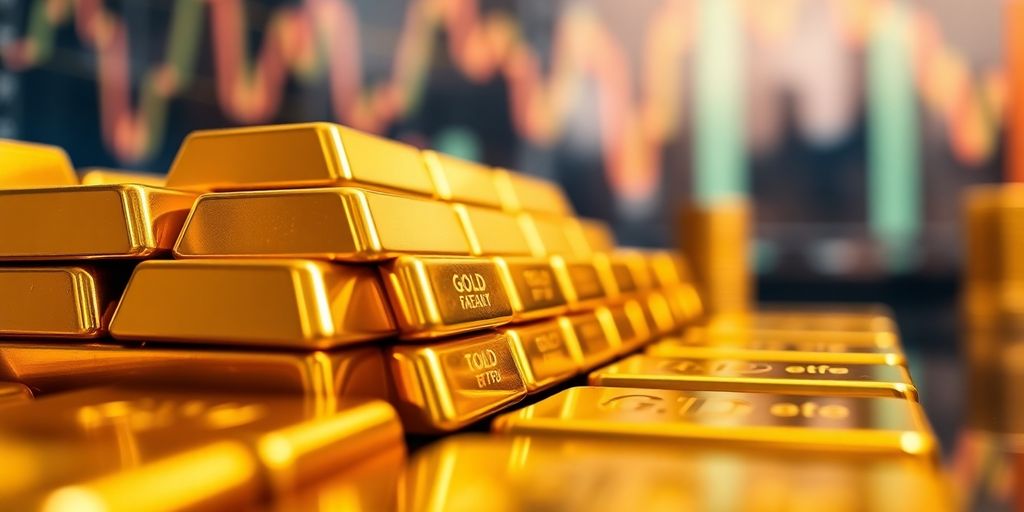Investing in gold has always captivated people, especially during uncertain economic times, one of the easiest ways to get exposure to gold without the hassle of buying physical bars or coins is through Gold ETFs.
These funds allow you to invest in gold in a straightforward manner, making it accessible for new investors, in this guide we’ll break down everything you need to know about how to invest in gold ETF, from understanding what they are to choosing the right one for your portfolio.
Key Takeaways
- Gold ETFs are a simple way to invest in gold without physical ownership.
- Consider factors like expense ratios and fund performance before choosing an ETF.
- Setting up a brokerage account is the first step to buying Gold ETFs.
- Be aware of risks such as market fluctuations and management fees.
- Understand the tax implications of your gold ETF investments.
Understanding Gold ETFs and Their Benefits

What Is a Gold ETF?
Okay, so what exactly is a Gold ETF? Simply put, it’s an Exchange Traded Fund that aims to track the price of gold.
Instead of buying physical gold, you’re buying shares of a fund that holds gold as its primary asset. It’s like owning a tiny piece of a giant gold bar without the hassle of storing it in your house. These ETFs trade on stock exchanges, just like regular stocks, making them easy to buy and sell.
Advantages of Investing in Gold ETFs
Why bother with Gold ETFs? Well, there are a few good reasons:
- Liquidity: You can buy or sell them quickly during market hours.
- No Storage Hassles: Forget about safes and insurance; the fund takes care of storage.
- Diversification: Easy way to add gold to your portfolio without a huge investment.
Gold ETFs offer a straightforward way to invest in gold without the complexities of physical ownership. They provide liquidity, eliminate storage concerns, and allow for easy diversification, making them an attractive option for both new and experienced investors.
How Gold ETFs Work
Gold ETFs typically hold physical gold bullion, and each share represents a specific amount of that gold. The fund’s price fluctuates based on the current market price of gold, some ETFs might also invest in gold futures contracts, but the goal is always to mirror gold’s performance.
The fund managers handle the buying, selling, and storage of the gold, and they charge a small fee (the expense ratio) for their services. It’s a pretty hands-off way to get exposure to the gold market.
Choosing the Right Gold ETF
Choosing the right gold ETF can feel like a big decision, but breaking it down into manageable steps makes it easier. It’s not just about picking any gold ETF; it’s about finding one that aligns with your investment goals and risk tolerance. Let’s explore the key factors to consider.
Factors to Consider When Selecting an ETF
When you’re trying to pick the right gold ETF, there are a few things you really need to think about.
First, what’s the investment objective of the ETF? Is it trying to track the spot price of gold exactly, or does it have some other strategy?
You’ll also want to look at the fund’s size – bigger funds usually mean better liquidity, which makes it easier to buy and sell shares. Also, consider:
- Tracking Error: How closely does the ETF follow the price of gold?
- Fund Size (AUM): Larger funds often have better liquidity.
- Underlying Index: What benchmark is the ETF trying to replicate?
Comparing Different Gold ETFs
Okay, so you know what to look for, but how do you actually compare different gold ETFs? Well, start by making a list of potential candidates then dig into their fact sheets and prospectuses, pay attention to their holdings – are they holding physical gold, or are they using derivatives?
Also, check out their historical performance, but remember that past performance doesn’t guarantee future results, you can also compare gold mining ETFs to see which one fits your investment strategy.
It’s a good idea to compare a few different ETFs side-by-side. Look at their key metrics, like expense ratios, tracking error, and liquidity. This will help you get a sense of which one is the best fit for your needs, you can also check the FAQ for a complete table.
Expense Ratios and Fees
The expense ratio is the annual fee that the ETF charges to manage the fund, they are super important because they eat into your returns. It’s usually expressed as a percentage of your investment, so if an ETF has an expense ratio of 0.25%, that means you’ll pay $2.50 per year for every $1,000 you have invested.
Lower expense ratios are generally better, but don’t focus on that alone, also consider trading commissions and other fees that your broker might charge. For example, SPDR Gold MiniShares Trust (GLDM) offers a lower expense ratio compared to some other options. Always factor in all costs to get a clear picture of your potential returns.
How to Invest in Gold ETFs

Alright, so you’re thinking about getting into gold ETFs? It’s not as scary as it sounds. Basically, you’re buying shares of a fund that holds gold, instead of buying actual gold bars. Here’s how to get started.
Setting Up a Brokerage Account
First things first, you’ll need a brokerage account. Think of it like a bank account, but for investments.
Here’s a quick rundown:
- Research brokers: Look for ones with low fees and a user-friendly platform. Fidelity, Charles Schwab, and Robinhood are popular choices.
- Open an account: You’ll need to provide some personal info and banking details.
- Fund your account: Transfer money from your bank account to your brokerage account. Most brokers let you do this online.
Placing Your First Order
Okay, you’ve got money in your account. Now it’s time to buy some gold ETFs.
Here’s the play-by-play:
- Find the ETF: Search for the gold ETF you want to buy. Common ones are GLD and IAU. Each ETF has a ticker symbol, check the FAQ section for a complete table.
- Enter the ticker: Type the ticker symbol into the search bar on your brokerage platform.
- Place your order: Decide how many shares you want to buy and enter the order. You can choose a “market order” (buy at the current price) or a “limit order” (set a specific price you’re willing to pay).
GLD vs IAU: What’s the Difference Between These Gold ETFs?
When it comes to investing in gold through exchange-traded funds (ETFs), SPDR Gold Shares (GLD) and iShares Gold Trust (IAU) are two of the most well-known options.
Both funds are designed to track the price of gold and provide investors with a way to gain exposure to the precious metal without physically owning it. However, there are key differences that can influence which is better suited to your financial strategy.
1. Expense Ratio:
One of the most noticeable differences is the cost. IAU typically has a lower expense ratio (around 0.25%) compared to GLD (approximately 0.40%). Over time, this cost difference can significantly impact returns, especially for long-term investors.
2. Liquidity and Trading Volume:
GLD is the larger and more liquid of the two, with significantly higher daily trading volume. This can make GLD more attractive to active traders or institutional investors who prioritize tight bid-ask spreads and ease of trading.
3. Share Price and Accessibility:
IAU has a lower share price, which makes it more accessible to smaller investors or those looking to buy in smaller increments. This can be ideal for retail investors just starting out or those implementing dollar-cost averaging strategies.
Bottom Line:
- Choose GLD if you value liquidity and are executing larger trades.
- Choose IAU if you prefer lower fees and more affordable entry points.
Regardless of which you pick, both offer a reliable and efficient way to add gold exposure to a diversified portfolio.
Monitoring Your Investment
So, you’ve bought your gold ETF. Now what? Don’t just forget about it!
Here’s what to do:
- Check regularly: Keep an eye on the price of your ETF most brokerage platforms have charts and tools to help you track performance.
- Stay informed: Read news and analysis about the gold market this can help you understand why the price is moving up or down.
- Rebalance if needed: Over time, your portfolio might become unbalanced, if gold becomes too big or too small a part of your investments, consider rebalancing to maintain your desired asset allocation.
Investing in gold ETFs can be a good way to diversify your portfolio, but it’s not a guaranteed win. The price of gold can be volatile, so be prepared for ups and downs, don’t put all your eggs in one basket and always do your research before investing.
Risks Associated with Gold ETFs
Market Volatility
Gold ETFs, while often seen as a safe haven, are still subject to market volatility, the price of gold can fluctuate based on various factors, including economic news, interest rates, and geopolitical events.
This means that the value of your gold ETF investment can go down as well as up, it’s not a set-it-and-forget-it kind of deal you have to keep an eye on things. For example, unexpected economic data could trigger a sell-off, impacting your investment. It’s important to understand that past performance isn’t a guarantee of future returns, and gold ETFs can experience periods of both high and low volatility.
Liquidity Risks
While gold ETFs are generally liquid, there can be times when it’s difficult to sell your shares at the price you want. This can happen during periods of market stress or if the ETF itself experiences low trading volume.
Liquidity risk is the possibility that you might not be able to quickly convert your ETF shares into cash without taking a loss. This is especially important to consider if you might need access to your investment funds on short notice.
Management Fees
Gold ETFs charge management fees, also known as expense ratios, which can eat into your returns over time.
These fees cover the costs of administering the fund, including storing the physical gold and providing custodial services. It’s important to compare the expense ratios of different gold ETFs before investing, as even small differences can add up significantly over the long term.
For example, GLD’s expense ratio exceeds several newer alternatives, consider the impact of these fees on your overall investment strategy, you can find lower-cost gold ETF strategies to optimize your precious metals allocation.
It’s easy to overlook management fees, but they really do make a difference over time. A seemingly small fee can significantly reduce your overall return, especially if you’re holding the ETF for many years, always factor in these costs when evaluating different investment options.
Tax Implications of Gold ETF Investments
Understanding Capital Gains Tax
Okay, so when you make money on your gold ETF investments, the government wants a piece, it’s called capital gains tax. How long you hold the ETF before selling determines the tax rate. If you hold it for a year or less, it’s taxed at your regular income tax rate, but here’s the kicker: if you hold it for longer than a year, it’s often taxed at a collectibles rate, which can be higher than the usual long-term capital gains rate for stocks.
This is something to keep in mind.
Tax-Advantaged Accounts
Want to avoid or delay paying taxes on your gold ETF gains? Consider using tax-advantaged accounts like IRAs or 401(k)s. These accounts can provide tax benefits, but it’s important to check if your specific plan allows gold ETF investments, not all plans do so it’s worth looking into.
Reporting Requirements
When you sell your gold ETF shares, your brokerage will send you a Form 1099-B.
This form has all the details you need to report the sale on your tax return, you’ll need to fill out Schedule D (Capital Gains and Losses) with this information.
Keep good records of when you bought and sold your shares, especially if you sold only part of your holdings. This helps you figure out your gains or losses accurately, many brokerages have tools to help you track this stuff, so use them!
It’s always a good idea to talk to a tax professional. They can give you personalized advice based on your specific situation. Tax laws can be complicated, and it’s easy to make mistakes, getting professional help can save you money and headaches in the long run.
Here are some things to remember:
- Keep detailed records of your transactions.
- Understand the difference between short-term and long-term capital gains.
- Consider using tax-advantaged accounts if possible.
Alternatives to Gold ETFs

Physical Gold Investments
Thinking about physical gold? You’ve got a few options. You can buy gold bars, coins, or even jewelry.
The big plus is that you actually own something tangible, but there are downsides, you need to figure out storage which could mean a safe deposit box at the bank or a home safe and that costs money plus you might need insurance to protect against theft or damage, selling it can also be a hassle compared to quickly trading an ETF.
One thing to keep in mind is the markup. When you buy physical gold, you’re often paying a premium over the spot price, and you might not get that back when you sell.
Gold Mining Stocks
Another way to get exposure to gold is through gold mining stocks. Instead of owning the metal itself, you’re investing in companies that mine gold. The upside is that these companies can potentially generate profits and pay dividends, which you won’t get with physical gold or gold ETFs.
However, gold stock performance can be volatile the value of these stocks depends on factors like the company’s management, mining operations, and the overall stock market not just the price of gold.
Gold Mutual Funds
Gold mutual funds are similar to gold ETFs, but they’re managed differently, instead of tracking a specific index, a fund manager actively picks which gold-related assets to invest in.
This could include gold mining stocks, gold bullion, or other precious metals. The potential benefit is that a skilled manager might be able to outperform the market.
However, actively managed funds usually have higher expense ratios than ETFs, which can eat into your returns plus there’s no guarantee that the manager will actually beat the market.
Here’s a quick comparison:
| Investment Type | Pros | Cons |
|---|---|---|
| Physical Gold | Tangible asset, good for long-term storage of value | Storage costs, insurance costs, selling can be difficult |
| Gold Mining Stocks | Potential for dividends, exposure to company profits | Stock market volatility, dependent on company management |
| Gold Mutual Funds | Potential for outperformance by fund manager | Higher expense ratios, no guarantee of outperformance |
Long-Term Strategies for Gold ETF Investment
Diversification Benefits
Gold ETFs can be a solid addition to a diversified portfolio, especially when you’re thinking long term. They don’t always move in the same direction as stocks and bonds, which can help cushion your portfolio during market downturns.
Think of it as an insurance policy for your investments it’s not about getting rich quick; it’s about protecting your wealth over time. The key is to understand how gold ETFs work within your broader investment strategy.
Rebalancing Your Portfolio
Rebalancing is crucial for maintaining your desired asset allocation, over time some assets will grow more than others, throwing your portfolio out of whack. Here’s how to rebalance with gold ETFs:
- Regularly review your portfolio: At least once a year, check how your assets are performing.
- Determine your target allocation: Decide what percentage of your portfolio should be in gold ETFs, personally in my portfolio I like to have a position around 5% in gold.
- Sell or buy assets: If your gold ETF allocation is too high, sell some to buy other assets if it’s too low, buy more gold ETFs.
Rebalancing isn’t about chasing the best returns; it’s about managing risk and staying true to your investment plan, it helps ensure you don’t become overexposed to any single asset class, which can be especially important in volatile markets.
Timing the Market
Trying to time the market with gold ETFs is generally not a good idea, gold prices can be unpredictable and you might miss out on potential gains if you’re constantly trying to buy low and sell high. Instead, focus on a long-term investment horizon and dollar-cost averaging.
This involves investing a fixed amount of money at regular intervals, regardless of the current price. This strategy can help you avoid making emotional decisions based on short-term market fluctuations.
Here’s a simple table illustrating how dollar-cost averaging might work with gold ETFs:
| Month | Investment | ETF Price | Shares Purchased | Total Shares | Average Price |
|---|---|---|---|---|---|
| Jan | $500 | $150 | 3.33 | 3.33 | $150 |
| Feb | $500 | $140 | 3.57 | 6.90 | $144.93 |
| Mar | $500 | $160 | 3.13 | 10.03 | $149.55 |
Wrapping It Up
Investing in gold ETFs can be a smart move for anyone looking to diversify their portfolio, gold has a long history of being a safe haven during tough economic times, and it can help protect your wealth against inflation.
When you start your investment journey, keep in mind the different options available and the risks involved. Remember, every expert was once a beginner, so don’t hesitate to take that first step, your chance to invest in gold is right in front of you go for it!
Frequently Asked Questions
What is a Gold ETF?
A Gold ETF, or Exchange-Traded Fund, is a type of investment that lets you buy shares that represent a certain amount of gold. It’s an easy way to invest in gold without having to buy physical gold bars or coins.
What are the most popular gold ETFs?
Here is a table with the most popular gold ETFs, usually investors go for either GLD or IAU.
| ETF | Backed by Physical Gold | Expense Ratio | AUM (approx.) | Key Feature |
|---|---|---|---|---|
| GLD | Yes | 0.40% | $50B+ | Most liquid, popular among traders |
| IAU | Yes | 0.25% | $30B+ | Low-cost alternative to GLD |
| SGOL | Yes | 0.17% | $3B | Gold stored in Switzerland |
| OUNZ | Yes | 0.40% | $500M | Redeemable for physical gold |
| BAR | Yes | 0.17% | $1B | Transparent and low-cost |
What are the benefits of investing in Gold ETFs?
Investing in Gold ETFs can be beneficial because they are easy to buy and sell, usually have lower fees than other investments, and you don’t have to worry about storing physical gold.
How do I choose the right Gold ETF?
When picking a Gold ETF, consider things like the fund’s fees, how much gold it holds, and how well it has performed in the past. It’s also good to compare different ETFs to find the one that fits your needs.
What are the risks of investing in Gold ETFs?
Some risks include market ups and downs, the possibility that you might not be able to sell your ETF easily and management fees that can eat into your profits.
Are there taxes on Gold ETF investments?
Yes, when you sell your Gold ETF shares for a profit, you may have to pay capital gains tax. It’s important to understand how this works to avoid surprises at tax time.
What are some alternatives to Gold ETFs?
Alternatives to Gold ETFs include buying physical gold like coins and bars, investing in gold mining stocks, or putting money into gold mutual funds that hold gold-related assets.




